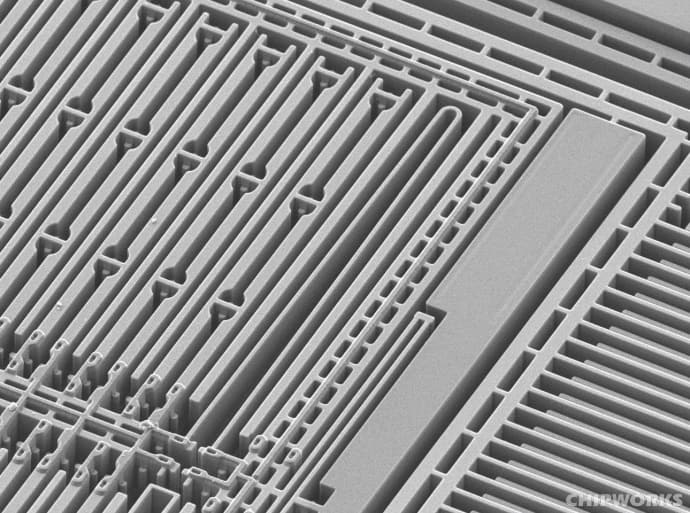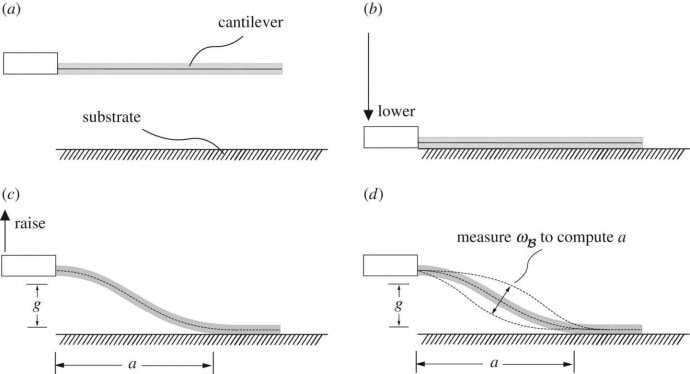
Accelerometers are typical MEMs, featuring tiny meshed fingers of metal. Adhesion prevents them from working
Things get weird at tiny scales. The very smallest level, the classical Newtonian laws of physics break down and the counterintuitive world of quantum mechanics holds sway. But even at slightly larger levels, the familiar forces that govern our everyday world can no longer be dominant. For example, for microscopic mechanical devices, known as micro-electromechanical systems (MEMs), adhesive forces between surfaces are the most important to designers. Researchers at Brown University in Rhode Island have devised a method to measure this force accurately for the first time.

The technique measures the vibration of a partially-adherted AFM microbeam Image: Kersari Lab/Brown University
MEMs are becoming increasingly important as compact electronic devices such as mobile phones and wearables become more ubiquitous, cheaper and available to more people and for more applications. One of the most common MEMs is the accelerometer, vital to measuring the movement of the device, and an essential component in fitness trackers.
"The main thing that matters at the microscale is what sticks to what," said Haneesh Kesari of Brown's School of Engineering and coauthor of the new research. "If you have parts of your device sticking together that shouldn't be, it's not going to work. So in order to design MEMS devices, it helps to have a good way of measuring adhesion in the materials we use."
Kesari’s work is devoted to measuring a quantity known as the “work of adhesion”, which is the amount of energy needed to separate a unit area of two surfaces that have stuck together. To do this, he and his team adapted an atomic force microscope (AFM). Normally, these devices work a little like a scaled down record player; a flexible microbeam, tipped with a sharp needle at right angles to the beam length, moves across the target material and the needle moves up and down with the undulations of the material. A laser shone down onto the beam measures the deflections, and this data is analysed to produce an image of the material.
The Brown team removed the sharp needle from the beam, and simply lowered the tiny length of flexible metal onto the target material. Because of the tiny scale of the component, adhesion forces come into play and it sticks. Raising it slightly makes one end of the beam come unstuck, while the free end remain stuck to the surface. The unstuck portion vibrates very slightly. In a paper in Proceedings of the Royal Society A, Kesari and the team discuss how they used the extent of that vibration, measured with the laser method used in normal AFM, to calculate the length of the unstuck portion of the beam, which can in turn be used to calculate the target material’s work of adhesion.
"Once you have a robust technique for measuring the material's work of adhesion, then you have a systematic way of evaluating these methods to get the level of adhesion needed for a particular application," said graduate student Wenqiang Fang. "The main advantage to this method is that you don't need to change a standard AFM setup very much in order to do this."
One major advantage of this technique over others that have previously been used is that it only requires a single measurement to determine the value for work of adhesion. Previous methods use interferometry, which requires many data points and more complex equipment.
This work is only a first step, the team stresses. The next stage is to gather experimental data on a range of materials and use this information to start designing new MEMs. "We have MEMS accelerometers and gyroscopes, but I don't think the field has quite lived up to its promise yet," Kesari said. "Part of the reason for that is that people haven't completely understood adhesion at the small scale. We think that a more robust way of measuring adhesion is the first step towards gaining such an understanding."




Poll: Should the UK’s railways be renationalised?
The term innovation is bandied about in relation to rail almost as a mantra. Everything has to be innovative. There is precious little evidence of...